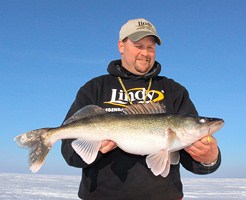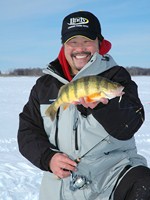Do Nothing Ice Fishing
Category: article
Feb 8th, 2012 by OutdoorsFIRST
Modified Feb 8th, 2012 at 12:00 AM
 |
|
| Even monster walleyes get the blues! When big fish are moving slowly at midwinter, it can be time to tame down your presentation. Jon Thelen of Lindy Tackle holds a bruiser taken on a Rattl’n Flyer Spoon, worked with the slow-or-no jigging approach he proposes in this article |
Sometimes in life, doing nothing, or nearly so, is the right thing to do.
Applied to fishing, that can be especially true during mid to late winter when fish become lethargic. When they won’t strike a lure jigged through the ice, try doing nothing.
That’s the advice of Jon Thelen, national sales manager for Lindy Fishing Tackle, who is also a guide and tournament angler. He grew up in Minnesota, where ice fishing is as popular as hockey and the Vikings. He’s learned a trick or two and one trick in his bag is to do nothing.
Thelen doesn’t care if the target is walleye, perch, or panfish. The time will come when leaving things well enough alone is the right choice.
Here’s what he means; Imagine a day on the ice when no bites come right away. What’s the first thing you do? Change location. That’s even true if you’ve done your homework on that particular lake and know deep down inside that the fish should be on that very spot you’re about to leave. Still, you move.
More time passes. Still no bites on the second spot you try. So you head to a third. Then a fourth. Somewhere in process, you may have thought the jig you’ve been landing limits with for days on that lake is somehow suddenly the wrong color so you switch. Then you try another color and another. Then maybe you switch from a jig to a spoon, and still nothing. Then you try jigging hard or smackin’ the bottom out of frustration. Still no takers.
Thelen has listened to people describe that exact scenario many times in conversations at outdoor sports shows. Then Thelen starts talking. He tells them to do nothing. Stay in the same place, leave the same jig on and do nothing. Just try letting the jig sit still for a moment. He means as still as you can. Often the result is, bang! Fish on!
“Its amazing to see the eyes light up when they realize they aren’t picking the wrong lake, not fishing the wrong location…that it’s something they can fix easily,” he said.
Somewhere along the way during his years on the ice Thelen realized walleyes, perch and panfish would sometimes ignore the jig he was working steadily in one hole. Instead, they’d take the dying minnow dangling from a dead stick down the hole near by. He realized they’d wanted the bait as still as it could be.
Thelen thought about it and suddenly it made sense. So often we cut a hole and start fishing right away. We drop lures, jigs, change up something, jig some more, then another and other.
“What it boils down to is not giving a fish the chance to eat it,” he said. “By stopping and being still, you’re giving a fish an ambush opportunity.”
We’ve had the same thing happen in open water. After casting lures for walleyes, smallmouth bass or muskies with no takers, we start to experiment with action. We make it more erratic, pulling, reeling, stopping, pulling, reeling, stopping and wham. A fish nearly tears the rod out of our hands. Lure action (and sometimes the lack of it) is often more important than color choice.
Thelen often applies the concept later in winter when the oxygen level in the water starts to drop. Walleyes and panfish are less likely to travel far for a meal or chase it down. The cold water makes them lethargic as the colder the water, the slower their metabolism, so they don’t have to eat as often. They become more opportunistic.
Thelen has jigged the Lindy Darter to make it look like a minnow trying to get away. “I jitter it around a little to make it look like a minnow trying to get away. If I don’t get a hit, I might change the colors. But I’m never, ever giving them an option to eat it. Then when I let it sit still, the walleyes are given the opportunity to rush in and grab it. They feel like they are in control.”
 |
|
|
Lindy Darter
|
With panfish, he can jiggle, jiggle, jiggle and get nothing. Several crappie or bluegill or perch might be sitting there looking at it waiting for an opportunity to pounce. “If I stop it, it can start a feeding frenzy. Think about it; we are fishing vertically. If you have a fish looking at the lure 2, 3, or 5 minutes, you are going to have to do something to trip his trigger. A lot of the time, stop the lure so the fish has time to attack.”
Once he realized the importance of doing nothing, he has seen many times when conditions are right for the tactic. He’ll be looking at his Humminbird ICE-55 and see fish on the screen peering at his jig only to see then move slowly to the side and grab his real minnow suffering the near death experience on the dead stick next to him.
“That tells me I’m being too aggressive with my jigging motion. When I see them grab the bobber rod, I have to slow down. I’ll jig it first, then stop and jiggle, then bounce down and hit the bottom. When I can see a fish, I’ll lift it like a fish trying to get away and then stop. That gives them an ambush point. As much as I want to believe fish aren’t smart, I think they’re brilliant. They get all these different options to eat. I think more often than not, they look at your bait and choose to not eat.”
Don’t get the wrong idea. You still have to drill holes where the fish are. Whether it be walleye, perch or panfish, Thelen targets deeper water in winter. Once the aggressive shallow bite is gone, he must go out and find fish, then get to bite. At times they will move onto structure. But the movements will be short and sweet. Deeper water is where they spend most of their time and you can catch fish all day long.
“You’re not looking for major league rock piles,” he said. “I want to fish all day. They will move on structure, but that will be slow. I’m looking for deeper areas where there may be a minor contour change in the bottom. It might be just a foot or even six inches. With my Humminbird GPS, I can follow along the contours. Look for any irregularities where a school of fish can sit and ambush bait.”
 |
|
|
When winter fish become sluggish, your jigging style can be most effective when it contains almost no actual jigging. Here Ted Takasaki holds a beautiful perch taken using the minimalist jigging methods taught by Lindy’s Jon Thelen.
|
The small contours often feature another advantage: a transition from hard to soft bottom. Walleyes will spend time on the harder bottom and move over the nearby mud looking for insects.
“Find changes in hard bottom to soft bottom,” says Thelen. “They always have a contour line attached to them. There’s a variety of food and more bugs are around. If there are bugs hatching, the minnows will be there. The walleyes won’t just lie in the mud. They will filter back and forth.”
Thelen uses a medium action, 30-inch rod to jig Darters with a spinning reel. For his dead stick, he’ll use a softer medium-light action rod, so he can reel down to a fish and load the rod before setting the hook to make certain all slack is out of the line. In ice fishing, so many tools favor the fish, such as smaller hooks and lighter line.
A medium-light action rod can help make sure there is a direct connection to the fish and that can put some of the odds back into his favor. He uses 6-pound Lindy Ice Line for walleyes, 3- to 4-pound line for perch and 2- to 3-pound for crappie. The line is designed so it doesn’t absorb water and resists freeze ups.
The Darter is his first choice of lures, followed by the Rattln’ Flyer Spoon and the silent Frostee Spoon with holographic color patterns.
Whatever lure you choose, remember to ‘Do Nothing’ with it. Sometimes that’s what you need to do to make something happen.